| Photojournal
- 1 April 2006
A
lost little lady
|
Those of you who know
me know that I don't typcially spend a lot of my time chasin'
women. I am a bachelor, but work and my photography tend to keep
me fairly occupied. So it may come as a surprise that on Saturday
I spent basically the whole day to go see a lady over on Vancouver
Island.
Then again, the world
will seem normal again once I tell you that the lady I was going
to see was a female Painted Bunting. This poor bird was far
away from home; in North America, she's a bird of the southeast
and south-central United States, and Mexico. The nearest part
of her normal range is probably southern New Mexico. This was
one lost bird. And she had been coming to a feeder in Brentwood
Bay for the last week and a half or so.
I ended up not sleeping
very well the night before, waking up at 1:30 and 4:30. After
the 4:30 waking (geese were honking outdoors for some reason),
I wasn't able to get back to sleep. So at 5:15 I decided to get
up and take the 7:00 ferry; I had previously been planning on
taking the 9:00 one.
I made it to the ferry
terminal a little before 6:30, and had some coffee (decaf - I've
given up caffeine) before boarding. Once on the boat, I bundled
up and headed for the outside deck with my camera. It was dark,
rainy, and miserable out, but I did get a few photos. My first
decent subject was a Bald Eagle flying out across the water.
|
|
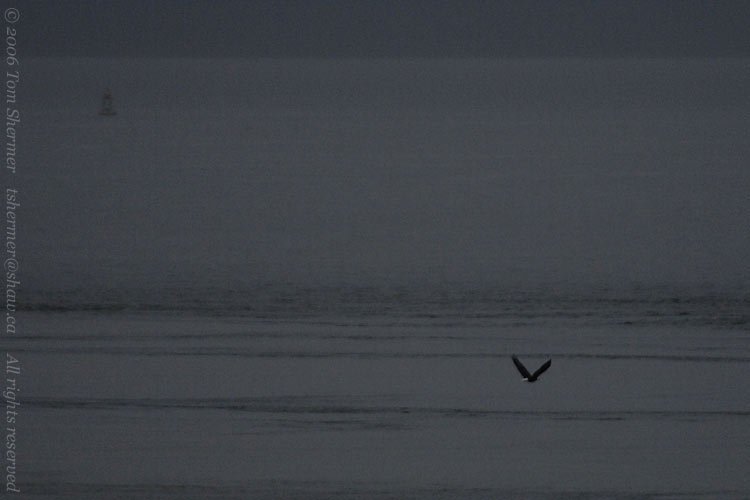 |
|
The ship started to
sail, and I stayed outside, braving rain and quite a bit of wind.
It wasn't very pleasant out there. Ah, but such are the demands
of photography.
I found only a few
birds as we went across the straight. The most interesting of
these were a small flock of Buffleheads, which are not only cute
little ducks, but also quite striking when in flight.
|
|
 |
| Coming
out of Active Pass, I took some landscape shots. |
|
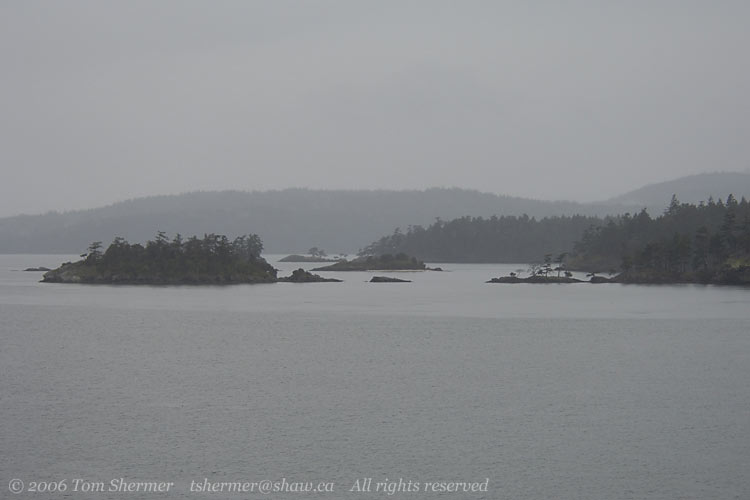 |
| Overcast
and chilly was the forecast for the morning, and my photos sure
were showing it. As we neared the ferry terminal at Swartz Bay,
I took a few last shots of the birds near the shore, including this
cormorant. By the length and thinness of the neck I think it's a
Pelagic Cormorant. |
|
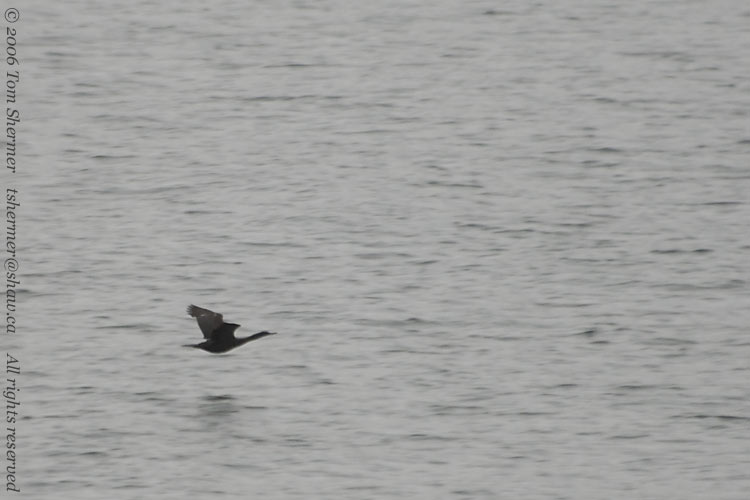 |
| Once on
the island, I drove down a small road rather than taking the highway.
The road took me past a field of daffodils. |
|
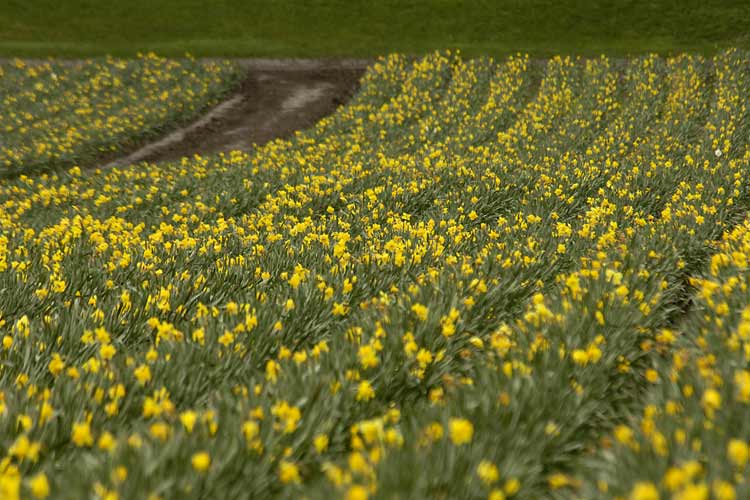 |
| A bit farther
along, I came across a small group of Brewer's Blackbirds on the
side of the road. This one is a male. |
|
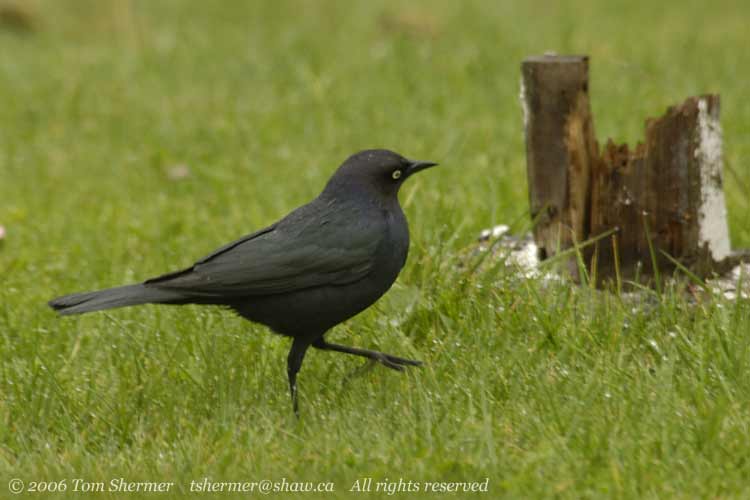 |
| And this
one is a female. |
|
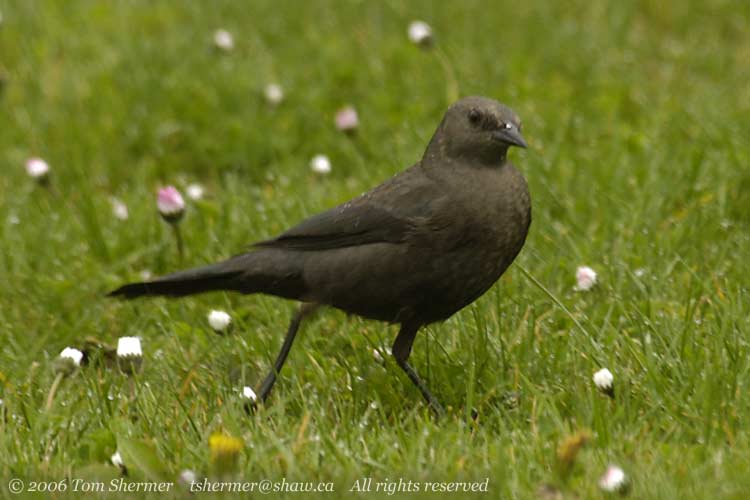 |
|
I reached Brentwood
Bay around 9:20, and found the house with the feeder that the
bird had been visiting. The instructions were to proceed up on
their deck, and so I did just that. Once in view of the feeder,
I set up my tripod and mounted my camera.
The area around the
feeder seemed a really popular place. I found six species of sparrows
there in the first ten minutes. First up was this House Sparrow.
|
|
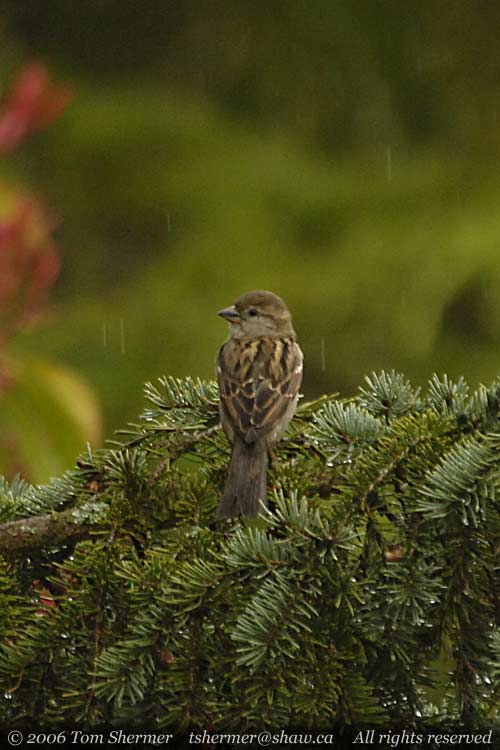 |
|
As you can see in that
photo, it was still raining. As you probably can't see, it was
still cold, too. I was partly under a roof overhang, but the end
of my lens was getting rained on. (I've always got a lens hood
on the lens, and that kept the rain off of the glass.)
On the ground below
the feeder, there was a Dark-eyed Junco poking around.
|
|
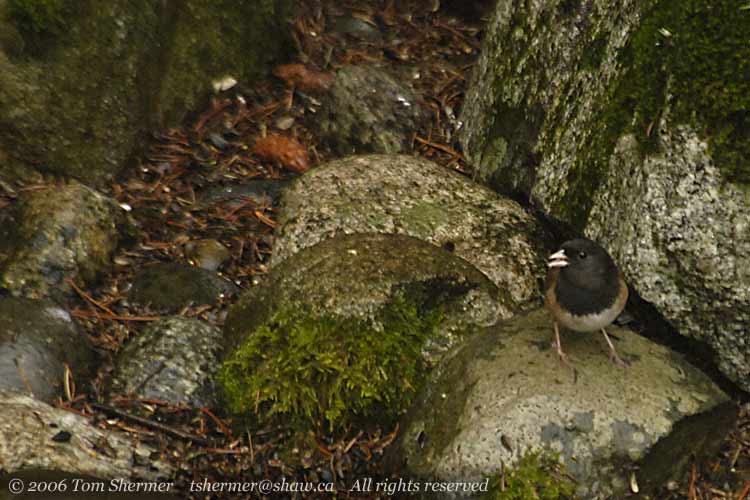 |
| I also got
photos of this White-crowned Sparrow up on a tree. |
|
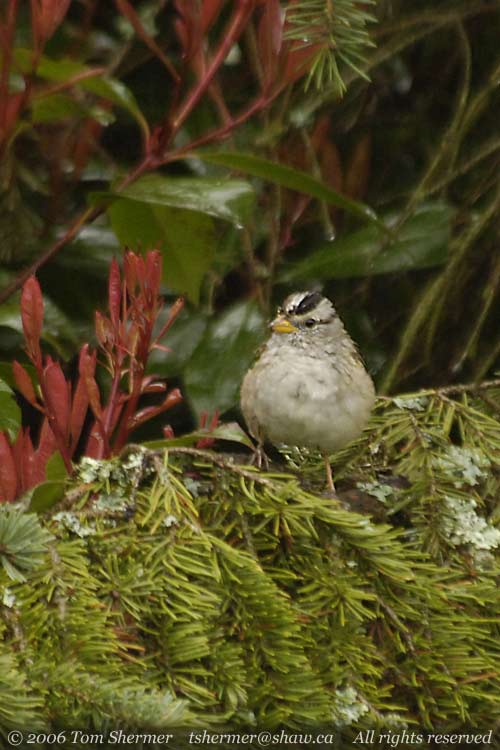 |
| And this
Golden-crowned one on the other side of the same tree. |
|
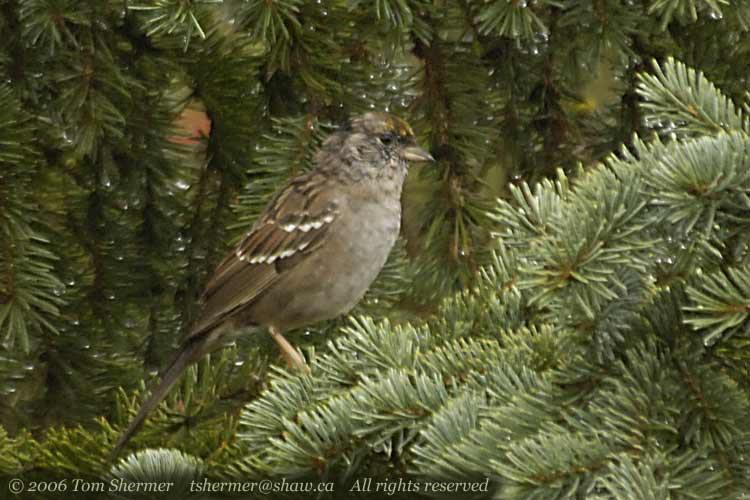 |
|
I think that he's molting
his face feathers and that's why his face looks so mottled.
The other sparrows
in the vicinity were Fox Sparrows and Song Sparrows. I didn't
take too many photos of them, and with the gloomy day working
against me, none of them turned out.
The sparrows didn't
seem to like the feeder, and kept either to the trees around it
or to the ground below. So I was a little startled when a bird
actually went to the feeder. I swung my camera up and caught him
as he looked right at me, recognizing as I did that he was a Bewick's
Wren.
|
|
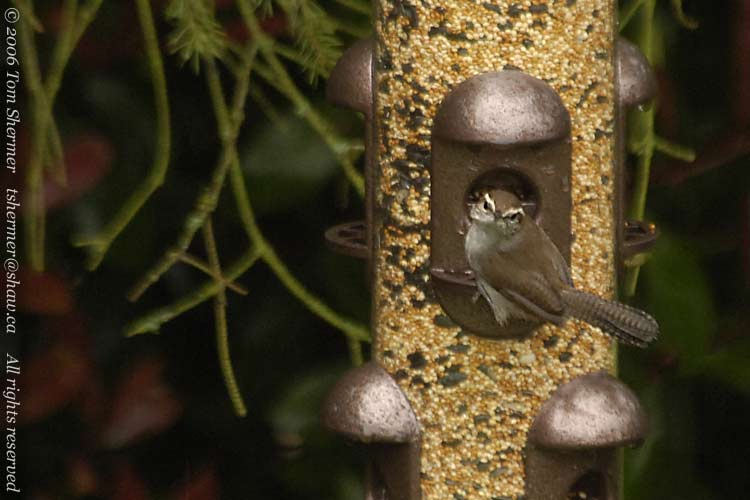 |
| A few shots
later I got a good profile of him. |
|
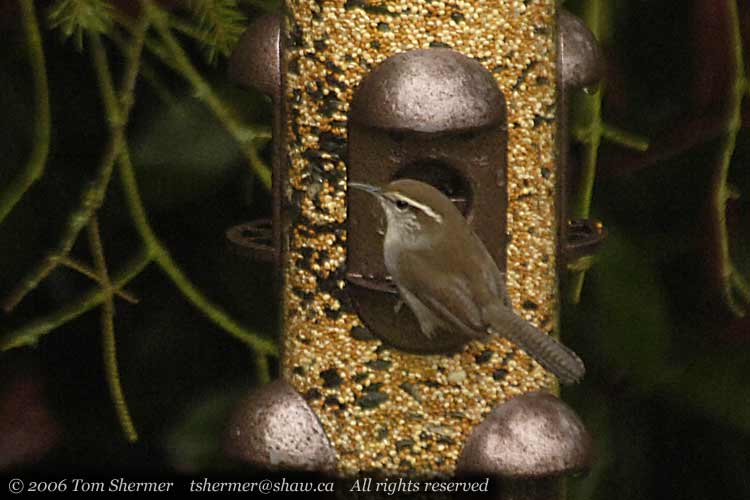 |
|
After about 45 minutes
in the rain and cold, another birder arrived and set up his telescope
next to my camera. Later, I learned that this fellow's name was
Chris, he was from Vancouver, and he had been on the ferry with
me. But we didn't say much at first, both hunkering down against
the elements. I tired of standing, and sat down in a plastic patio
chair, despite it having a wet seat cushion. I figured that my
bottom might be a bit colder, but at least my legs would get a
rest.
We waited on, with
no buntings showing up. After about 30 minutes, another pair of
birders arrived. As the damp got to me I began to wonder how long
I should wait. Maybe the bird had moved on.
After another ten minutes
or so, I stood up and got behind my camera. I waited.
Finally, around 11:00,
after I had waited in the damp cold for over 90 minutes, Chris
spotted the bird. She was near the base of the tree that was behind
the feeder. Next, she flew up into the tree, and to the feeder.
I caught her there.
|
|
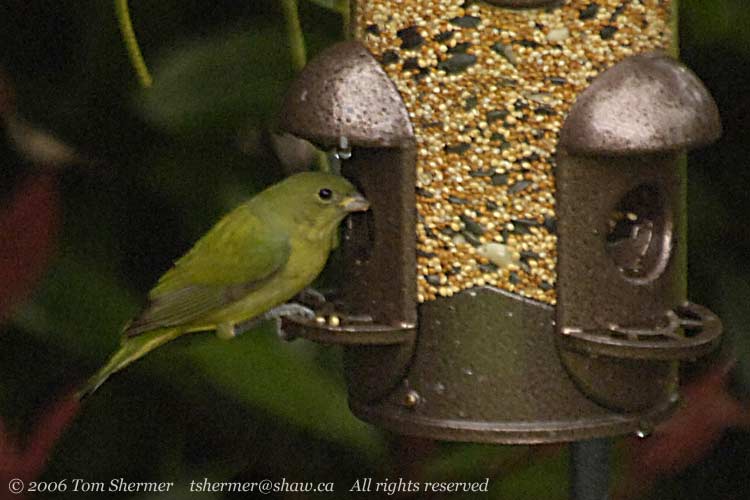 |
| This girl's
yellow-green plumage was quite pretty, but it was also functional.
She modelled it on a tree branch to show just how good it was as
camoflauge. |
|
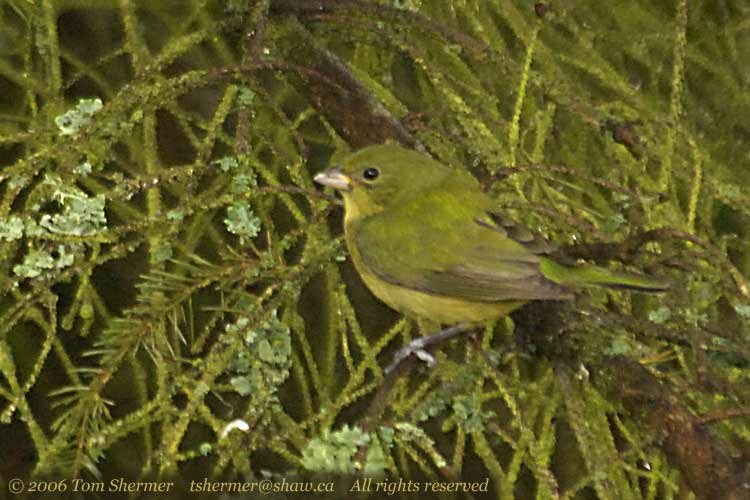 |
|
Although this bird
was striking, male Painted Buntings are even more so, with a bold
blue head, red body, and yellow-green wings.
I got a number of shots
of the bunting, but the distance wasn't that great and the low
light levels meant that the camera had difficulty focussing and
that the photos would turn out grainy. Despite those difficulties,
I decided to put my 2x teleconverter on the camera, to try to
compensate for the distance. The teleconverter throws away a bunch
of light, so the exposures got longer and the photos I got turned
out even more grainy. This was the best of the bunch.
|
|
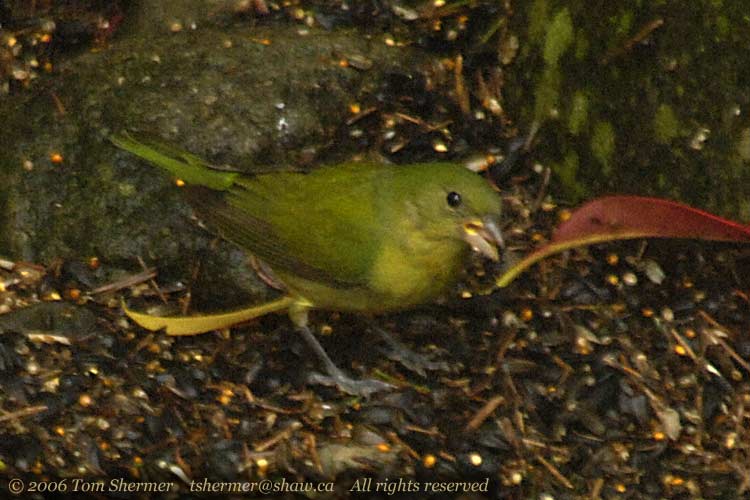 |
|
That last shot was
actually about a half an hour after the first one. Inbetween them
the bunting had flown away: She had only been present for about
ten minutes.
But in those ten minutes
I had gotten about the best photos I could hope for, given the
conditions. So I decided to move on, although first I chatted
a bit with the others who had gathered there. Chris had come by
bus, so I offered him a ride back to the ferry. We briefly thought
about going out to Whistling Spit to look for a Say's Pheobe that
had been spotted there, but decided not to when we found out that
Whistling Spit was a fair drive south and west, away from the
ferry.
On Vancouver Island,
there is a small population of a mainly European bird, the Sky
Lark, which was introduced some time back. It turned out that
the daffodil field where I had stopped earlier in the morning
was one of the best places to find this bird. A piece of good
luck was that Chris was from England, where Sky Larks are very
common, and he was adept at hearing them and spotting them. So
on the way back to the ferry we stopped at the daffodil fields.
On getting out of the car, Chris reported hearing larks.
Following Chris' ears,
we walked a short way down a muddy track beside a small resevoir.
In the resevoir were a pair of Ring-necked Ducks; I was hand-holding
my camera now, but I still got a decent shot of the male.
|
|
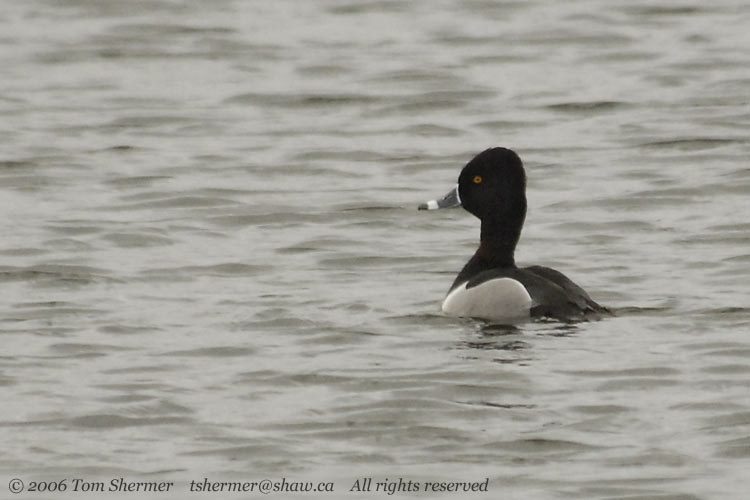 |
|
I like Ring-neckeds,
the white outline on the bill and between the grey and black parts
is very neat and pleasing to my eyes. These particular ducks were
fairly brave; all they did was paddle away to the other side of
the rather small resevoir. Most Ring-neckeds that I've seen before
didn't tolerate humans that close and would have flown away.
At the far end of the
resevoir, Chris spotted a Yellow-Rumped Warbler. This was the
first one that either of us had seen this year. This bird was
of the Audubon's subspecies, which has a yellow throat.
|
|
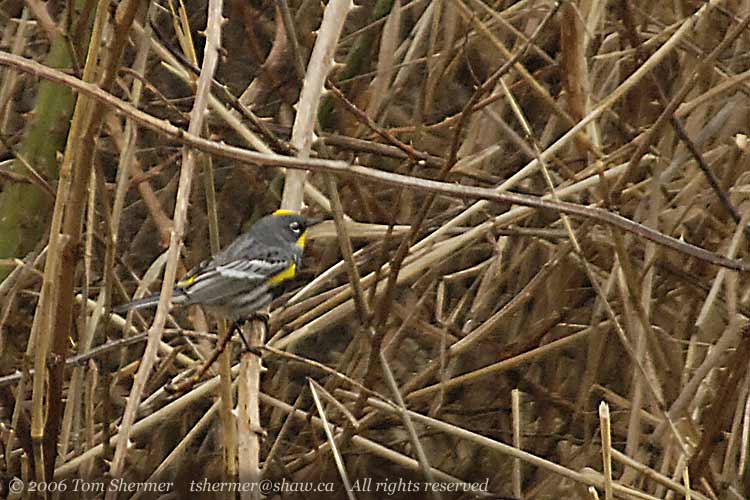 |
|
According to all of
my sources, finding a Sky Lark on the ground is a fairly rare
event. They tend to stay, appropriately enough, in the sky. So
I wasn't that surprised when Chris found the lark he was hearing
in the sky above us. He pointed it out to me and, although it
was a small dot way up there, I was able to get my binoculars
on it and watch for a while. While I watched, the bird drifted
a long way almost straight down, pausing once or twice to float
in the air for a few seconds. According to Chris, this is very
typical Sky Lark behaviour.
After watching another
lark that Chris pointed out, and trying without success to get
it focussed in my camera viewfinder, I figured we should be getting
on to to the ferry and so we headed back to the car.
Along the road to the
ferry we saw several Turkey Vultures overhead. I pulled over to
take photos of one, but just then a Common Raven had started chasing
it, and the two birds disappeared above some trees. So we made
it to the ferry without me getting any more photos.
There was no interesting
birding at the ferry terminal, and our next birding opportunity
was from the passenger deck on the ferry. Thankfully, the rain
had stopped a bit earlier, the cloud layer had lightened, and
it had warmed up a bit. It was quite comfortable on deck.
Chris pointed out some
Pigeon Guillemots off to the side of the ferry. These are a fairly
common bird around these parts, but somehow I'd never seen any
before. These birds have bright red feet.
|
|
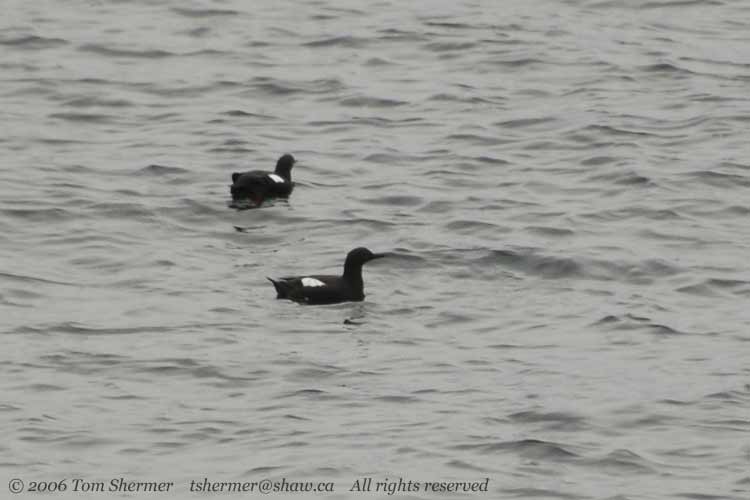 |
|
Once the ferry was
underway, we headed up to the bow, despite the wind over the water
being a fair bit stronger than in the bay. It was nice having
Chris with me, as he was pretty good at spotting birds out on
the water, seeing things that I would have missed, due to either
inexperience or concentration on taking pictures of something
else. And I always enjoy hanging out with more experienced birders.
As we headed out, we
passed a number of channel markers on our starboard. Here's one
with a pair of cormorants on it: Pelagic Cormorant on the left,
and Brandt's Cormorant on the right.
|
|
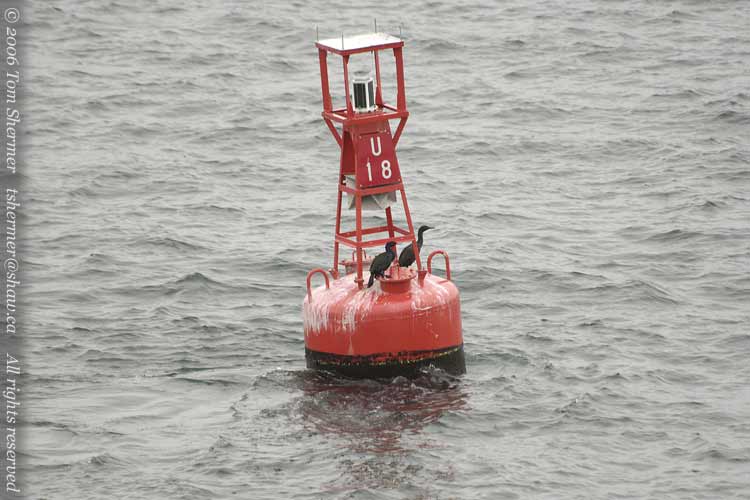 |
|
I'd never gotten such
good views of Brandt's Cormorants before. But even better views
were next.
The next marker we
passed was a larger one, and it had seven or eight cormorants
on it, mostly Brandt's. In the following photo, all but the rightmost
bird are Brandt's. Brandt's Cormorants in breeding plumage have
wispy white plumes that come out of the side of their head. In
the photo, these plumes are most obvious on the bird just to the
right of the front vertical red piece.
|
|
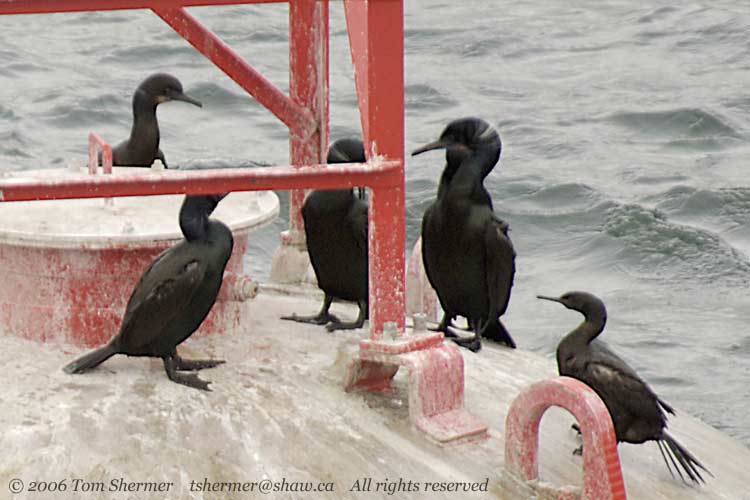 |
| Brandt's
cormorants also have a bright blue crop (or more scientifically,
gular pouch), which they can use for display purposes. In
the following photo, the two birds facing one another are engaged
in some sort of display. |
|
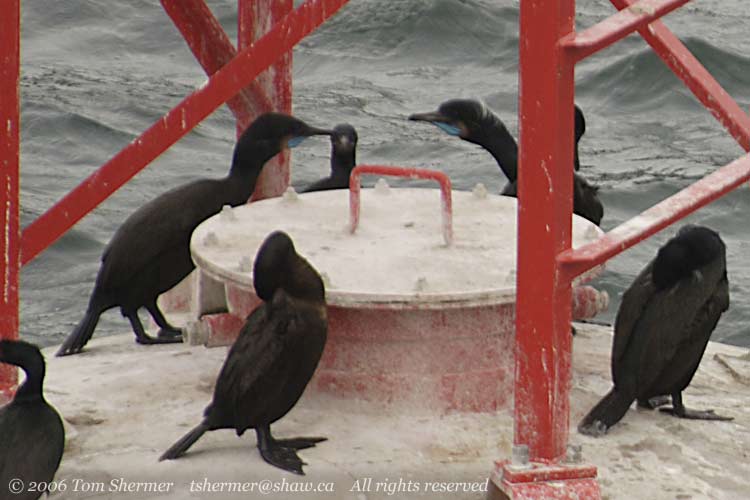 |
| I'm not
sure if they were greeting one another, courting, or agressively
facing off. Whatever was going on, the left bird continued quite
dramatically. Big crop, mouth open wide, head thrust foward, and
wings held open: this bird meant to impress, that's for sure. |
|
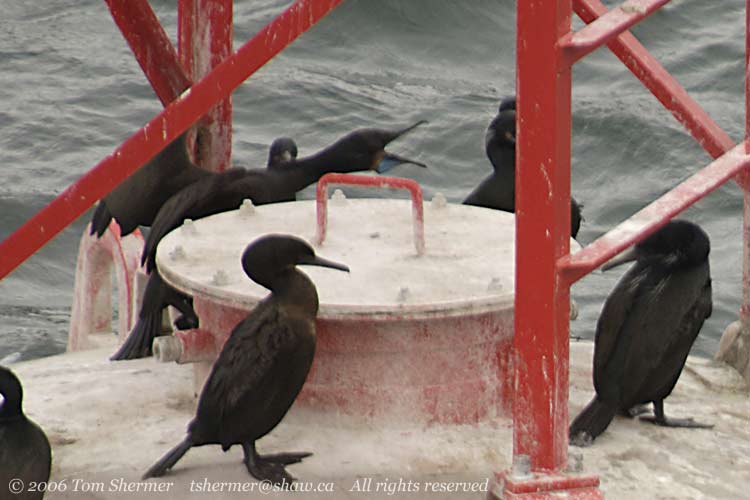 |
|
As the ferry headed
on towards the gulf islands, we found that the port bow was less
windy than the starboard, and so we kept watch from there. Chris
soon found several Rhinocerous Auklets on the port side and pointed
them out to me.
I was happy to see
the Rhinos; they're a distinctive little bird. Here's a pair of
them. These birds were already in breeding plumage, and show the
little white vertical "horn" for which they are named
on the side of their bills.
|
|
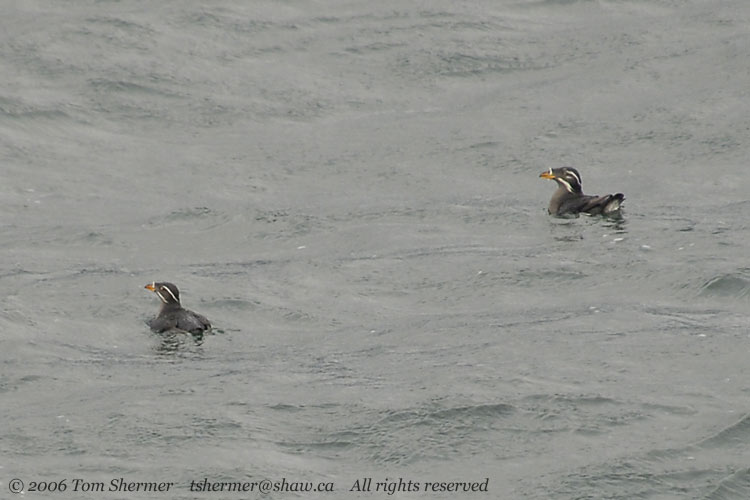 |
|
We were soon over relatively
open water, so Chris and I ducked inside and waited there until
we were close to land again. As the ferry approached Active Pass,
we went back to the port bow. There I took this photo of a small
island in the pass. Those whitish lumps are all Harbour Seals.
On another day, I'd say that those seals were out sunning themselves;
this time I guess they were out clouding themselves.
|
|
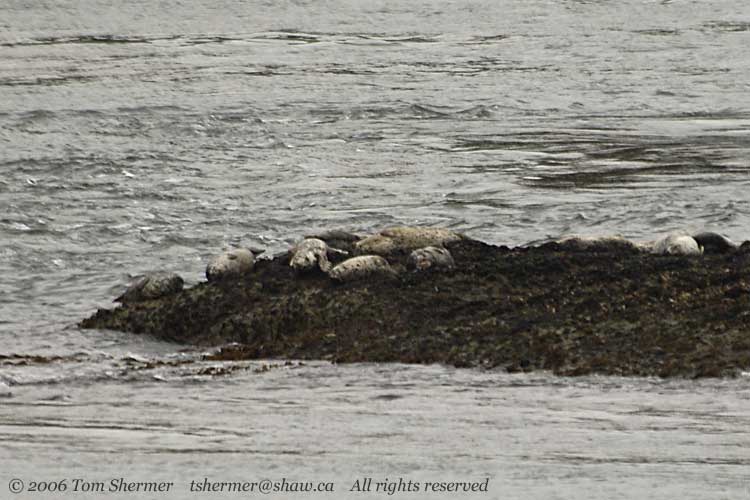 |
|
A little later, Chris
pointed me at a flock of gulls. It was a mixed flock, with some
Bonaparte's Gulls and some Mew Gulls. Of the four flying gulls
in this photo, the rightmost one is a Mew, and the other three
(including the rear one, with the black head) are Bonies. I can't
remember having seen breeding-plumaged (black-headed) Bonaparte's
before, so that was neat.
|
|
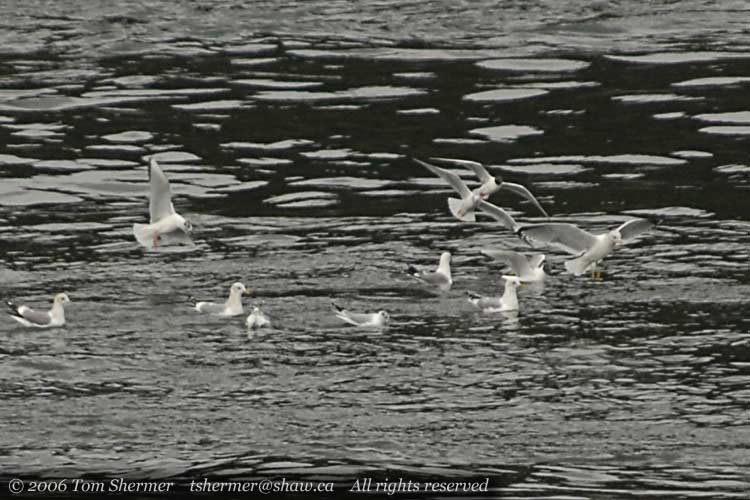 |
|
And the following is
a flock of mostly if not all Bonaparte's Gulls. The contrast of
their white-edged wings with the dark water made for quite a pretty
sight.
|
|
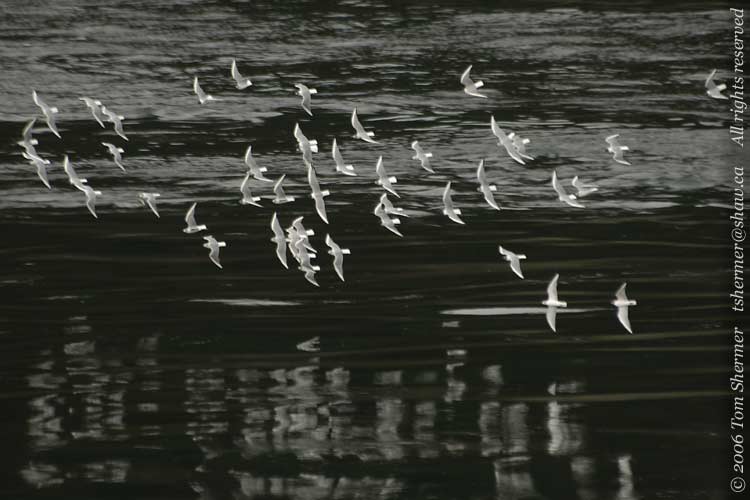 |
|
As we left Active Pass,
there was a loose-knit flock of loons off to starboard. They had
smallish bills and a brightish smudge on the back of their head;
this identified them as Pacific Loons. Here's a smudgy picture
of a few of them.
|
|
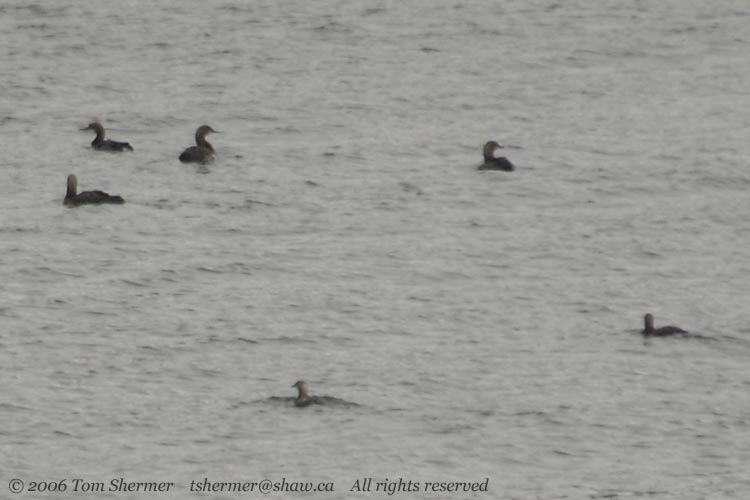 |
| The ferry
next headed across the straight, and Chris went inside while I lingered
to see if I could find any more subjects. The only interesting thing
I found was this back and fin sticking up out of the water. Based
on the shape, color, and size, I'd guess that this was a Harbour
Porpoise. But that is just a guess. |
|
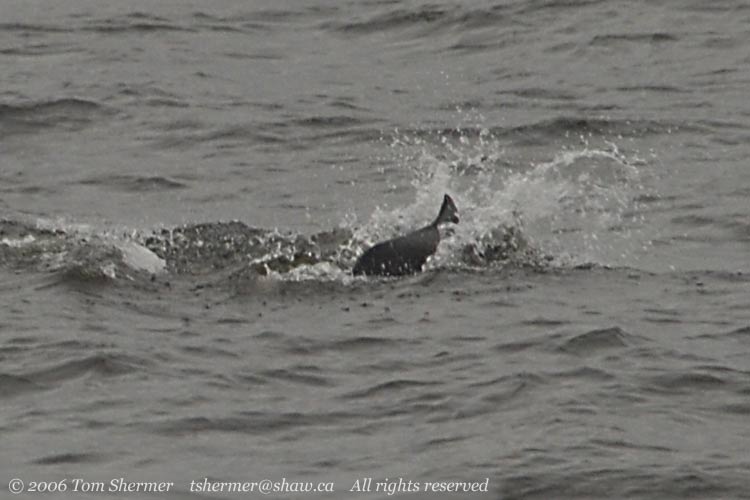 |
|
I rode outside until
we neared the Roberts Bank port and the ferry terminal. Once we
were off the ferry, I dropped Chris at the Ladner bus loop and
did some shopping before heading home.
Back at the condo,
I got in a few more photos as I walked through the courtyard;
a rain-speckled flower had caught my eye. I think it's a Rhododendron,
but I don't know the variety. I liked the yellow-and-green leaves
it had.
|
|
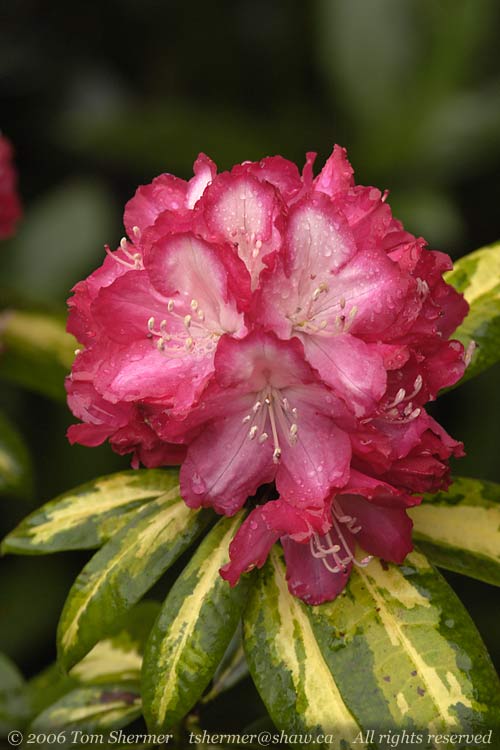 |
|
When I got back home,
it was a little after 5:00, and I was very tired. I ended up crashing
in bed before I even downloaded and checked my photos.
It had been worth it,
though. It was a glorious start to the second quarter...and I
didn't even have to suffer any April Fools' jokes.
Goin' where the rhinos
go,
Tom
|
|
|